 |
|
|||||||||||
|
|||||||||||
|
|||||||||||
|
|
|
|||||||||
|
||||
 |
|
|||||||||||
|
|||||||||||
|
|||||||||||
|
|
|
|||||||||
|
||||

App-Promo and Tapped Mobile have survived the madness of CES 2015 and are pleased to present a curated half day morning session on Thursday January 16th at the TIFF- Bell Lightbox, recapping CES 2015 with a panel of the top digital executives in Canada discussing implications from CES and insights into how they see the year ahead unfolding.
Enjoy a cup of coffee, light breakfast, and come in from the cold to warm up with Mobile Insights 2015.
Event Overview
8:30 Registration, Networking, Coffee and Light Breakfast
9:00 Welcome and Opening Comments.
Jed Schneiderman, CEO TappedMobile
Gary Yentin, CEO App-Promo
9:15-9:30 CES 2015 Wrap Up
9:30-10:00 Agency Insights
Jake Norman, CEO Mindshare Canada
Bruce Neve, CEO Starcom MediaVest
Will Pate, VP Digital Strategy, M2 Universal
Matt Di Paolo, Managing Director Digital Innovation, Sidlee
Moderated by Jed Schneiderman, TappedMobile
10:00-10:30 Brand Insights
Jonathan Dunn, Associate Director Sales Marketing, Bell Digital Media
Rahul Raj, VP Marketing of Ecobee
Mark Childs, Chief Marketing Officer, Samsung
Moderated by Gary Yentin, App-Promo
10:30-10:45 Mobile Personas 2015
Mark Baltazar, Vice President, Brandspark International
10:45-11:00 Recap and Questions and Answers
Registration Information
Registration is limited to the first 100 registrations and is free for qualified agencies, brands and digital innovators. Simply click on bit.ly/Mobileinsights2015 to register
Apple's App Store Has A Big Search Problem, And This Developer Has Proof http://t.co/Ug9k7wiG2T via @sai
— App Promo (@AppPromo) December 18, 2014

What all marketing efforts boil down to is results. For applications, the most common metrics are usually either downloads or activity. In this final article in our 10-part App Marketing 101 series, we break down what you need to know to properly assess your marketing efforts for your app.
Although results are gathered at the end of any marketing campaign, it is imperative that analytics and monitoring be considered right at the start of any effort. Metrics are intrinsically tied to the goals and objectives of the campaign. It is during the planning phase of your marketing effort where you not only identify these goals but should also be detailing how you will measure each objective in order to determine if they are successful or not.
Once you understand what data you need to collect, you will need to pinpoint what methods or resources you will need to gather that information. Understanding the methodology you need will ultimately influence the decisions you make in implementing your marketing efforts – which is why it is important to do this all upfront.
When the campaign is underway, don’t wait until the end to start to look at the data. Monitor your results throughout your efforts to see what is working and what is not and make the necessary adjustments. Just be sure that you give your choices enough time to culminate before changing them up again.
At either the end of your campaign or at particular milestones in your ongoing marketing, you will want to put all the pieces of information together to gauge the full impact of your efforts. Identify and celebrate your successes but don’t be afraid of points of failure as these are valuable learnings to take into your next attempts.
What to Measure?
The short answer is to this question is everything possible, but here are some typical metrics you should be collecting and analyzing in your marketing efforts.
Analyzing App Downloads
When it comes to apps, the first metric that comes to mind is downloads.
When looking at your downloads, consider more than just the total number. Look at what your peak times are for downloading to help determine key time slots for future marketing for your users.
All app stores provide geographic information that should be taken advantage of. Breakout your downloads by country to determine your geographic heat spots. Doing this will help identify where the most interest is from your users, another insight to take into future marketing and product efforts.
If your product has both a paid version and a free trial or “lite” version, analyzing your downloads for both during the campaign will help you assess your pricing model. Are those that are downloading your lite version converting to paid? If not – look to either the process to upgrade or the price point.
Ultimately, while running any elements of your marketing campaign, you will want to look back at the impact of these efforts on your downloads. To gauge the full impact, compare significant amount of download data pre-campaign against the campaign period (and if possible also against post-campaign results). Additionally,
Before any marketing effort, be sure to baseline your downloads to allow you to quickly identify if your efforts are producing growth. Calculate both the total downloads prior to starting your marketing efforts as well as your average daily growth and use these numbers to compare against results during the campaign.
Looking at activity to understand your true user
Although downloads are a good stat to focus on in terms of interest in your app, if your goal is to understand the use of your app you are going to want to include activity as a core metric in your monitoring.
There are two main places to gather information on usage of your app. The first in in the app store via the reviews and ratings attributed to your app. Keep an eye on these as you continue your marketing. Are you increasing the number of reviews and ratings? Have these improved with your marketing efforts? What are your users telling you during this time?
As ratings & reviews are being calculated along with downloads to help position applications in storefront charts and features, it is definitely something you will want to include as part of your marketing goals.
The second place collecting data on your user’s activity is within your app itself, well that’s if you planned ahead in your product development to include statistics to do so. Implementing an analytics package when developing your app will go a long way in helping you truly understand the success of your app.
Take a look at the activity within your app during your marketing. Do you see spikes in activity that correlate to your campaign elements? How do these compare to the increase you may be seeing in downloads? Are new users staying an using your app or downloading it and leaving it behind? What areas are they most interested in?
By analyzing user activity – you will get a better sense of the longer term impacts of your marketing efforts. These metrics give insight to your users rather than those that are simply interested in your product, perhaps because of compelling positioning in your marketing campaign (short-term impact of marketing).
Analyzing PR & Online Buzz
A core part of any marketing campaign is to get the word out. Whether this is through a formal press release over the wire or through a more personal outreach to bloggers and online publications you are going to want to understand how successful your PR efforts have been.
If you are using a PR distribution system to send out a press release, some of these metrics are easily available via the reports they provide. Look especially to both the number of online pickup achieved through their network and the types of sites that ran your release.
If you are reaching out to press and bloggers through an email system, look to your open rate to gauge interest and then search online using keywords from your release to understand who ran your story.
Without investing in tools or systems that are devised to do so, the best way to gauge online buzz is through good ol’ fashion search engines. Search for your app name or other keywords during your campaign and make note of the sites that mention your product.
A great way to track reader usage is through URL tracking sites like the use of bit.ly. By converting your download page link, for example, into a bit.ly URL you will gain a better understanding of the traffic pushed to download your app from referring sources.
Of course, you will ultimately want to look to your downloads and usage during this time to gauge impact of the posts achieved to see if they result in achieving your overall campaign goals. This won’t be a one-to-one correlation but you will be able to infer spikes of download or activity during peak periods of online buzz, especially if this is isolated from other marketing campaign elements.
Understanding data from Paid Media
Out of all of the marketing resources you utilize in your campaign, paid media will come with the most amount of readily available real-time data.
When running mobile, online or search ads – it is best to split-test. Run a couple of versions of your ad at the same time and then look to the analytics provided to decide what is working and what needs to be stopped or changed. Monitoring this continually through your campaign will not only improve the active campaign’s overall results, but it will also teach you what to continue in future marketing efforts.
Whether it is during the campaign or at the campaign end, you are going to want to look not to the impressions made during marketing (unless your goal is pure brand awareness) but rather the connections or clicks made during the campaign. This is where the click-through-rate is important or as it is usually denoted “CTR”.
You will want to understand what a good CTR is for a campaign in order to quickly make a decision if the campaign is worth putting money into. Although these are always specific to the network and ad trafficked, industry CTR averages are available for speculation online so take a look at these conversations to help put things in perspective. Ultimately, you will want to run a few test campaigns yourself on various networks to really understand what to expect in using paid media for marketing your app.
Measuring Social Media
Like online buzz, you will want to look to your social media efforts during marketing to understand how they helped deliver results.
Facebook makes this incredibly easy through the use of their Insight tool if you are a page administrator. This tool not only breaks out user activity, but can also provide data by post (impressions, activity) and demographic. Like Paid Media, you can use the data in Insights to see what type of posts are working for your community and which are not. Outside of Facebook’s Insight reports, use tracking services like bit.ly to understand who is entering your community to ultimately download your app.
For other social networks, like Twitter, you will need to lean on third party metric systems to really get a sense as to how your marketing efforts are doing within these communities. However, without investing too much money on these services, you will be able to look to your follower growth and perform searches to see what people are saying about your product. Again, the use of a tracking URL will also help to determine referral traffic to your download page. But unlike Facebook, most other social networks are not yet well set-up to provide you with additional data (like number of reads on your tweet etc.) so if this is of interest to you, you will have to look for alternative analytics solutions which do exist to integrate with.
Regardless of social network, you will want to look to follower or fan growth and sustenance as a metric to indicate interest in your brand and use of any download links
Starting today, you can invite up to 1000 testers to beta test your iOS apps, simply by sending an email invitation through iTunes Connect. Once your testers accept your invitation, they can install your beta app on their iOS devices, get push notifications for updated builds, and provide feedback, all within the TestFlight app.
Learn more about TestFlight Beta Testing.
Engage customers with a short video of your app in action, directly on your app product page on the App Store. By showing the experience of using your app, app previews can help customers better understand your app and encourage more downloads.
An app preview demonstrates the features, functionality, and user interface of your app in a short video that users can watch right on the App Store. Each preview is between 15 and 30 seconds long and is displayed as the first image on your App Store product page, followed by your app screenshots.
With iOS 8 and OS X Yosemite, you can capture real-time footage of your app directly from your iOS device. Simply connect your device to your Mac using the Lightning connector and it will be automatically available as a video camera. You can capture anything you’re doing on-screen directly to your Mac using QuickTime Player. Edit your captured footage in iMovie or your favorite video editing app and upload it to iTunes Connect for review along with your next app update.
If you submit app previews they will appear in all countries where your app is available. However, you may only submit a single set of app previews designed for iPhone, iPod touch, and iPad in one language localization.
Just like screenshots, each app preview is device-specific and requires an iPhone, iPad, or iPod touch with a 4-inch Retina display to view or submit. For detailed technical specs and step-by-step instructions on how to submit app previews, read the iTunes Connect Developer Guide.
App previews are between 15 and 30 seconds long and it’s important to make the most of this time to help customers better understand your app’s content and features. These tips will help you create a great app preview that sparks interest and drives downloads of your app.
App previews use footage captured on device to show the experience of using your app. Users want to see an honest depiction of what to expect from your app, so resist the urge to overproduce your video. Consider these steps as you structure the content and flow of your preview.
App previews are for all audiences, so your preview must be 4+ appropriate. Avoid objectionable content, violence, adult themes, and profanity.
App previews are between 15 and 30 seconds in length. Make the most of this time to show what makes your app special.
Capture app footage from the device using QuickTime Player on OS X Yosemite. Don’t film people interacting with the device (such as over-the-shoulder angles or fingers tapping the screen). Stay within the app.
Show only material you have the legal right to display. If your app displays protected content such as music, film, trademarked characters, brands, or other intellectual property assets, ensure you have the appropriate licensing rights for your marketing use in all territories. If your app accesses the iTune Library, use only song that you’ve created or that you’ve specifically licensed for use in the preview.
Add graphic elements, such as touch hotspots, only when necessary to demonstrate how navigation or interaction work within the app. Don’t overlay animated hands simulating Multi-Touch gestures.
We recommend capturing the native resolution of the UI; avoid zooming in on the view. Ensure the transitions between scenes don’t imply functionality that your app doesn’t have. Use straightforward transitions like dissolves and fades.
For games, show a higher ratio of gameplay to cutscenes. Cutscenes may mislead your audience by giving a false impression of gameplay. Get your audience excited about the elements they will actively engage with once they download the app.
App previews are displayed as the first image on your app’s product page, followed by your app screenshots. This is one of the first elements a user will see on your product page, so ensure the preview poster frame is visually compelling.
Ideally, your preview poster frame should convey the essence of the app. If the default frame selected from your footage doesn’t convey this, you can select a new frame in iTunes Connect. Please note that changing the poster frame on previews that have already been approved will require a new binary version.
App previews are not localized, so we recommend limiting the use of copy to maximize engagement globally.
When copy is necessary to give context to the footage, use easily understandable terms and consider language choice in light of your target audience.
Ensure text is legible and remains on screen long enough for your audience to read it.
To keep your app preview timeless, we recommend avoiding references to specific events, seasons, or memes that will date it (such as “New for spring!”).
We recommend leaving out references to pricing in your app preview. Pricing is already shown on the App Store product page, and references within the preview won’t be accurate in all countries and territories.
If you display features that are only available through In-App Purchase you must disclose this, but it’s a good idea to show it even when the In-App Purchase is optional so that users know what to expect. Disclaimer copy can be included contextually within the footage or in the end frame.
If your app uses a subscription model or requires login, we recommend identifying this in your preview.
Consider overlaying the musical score of your app as the soundtrack to your app preview. Overlaying ensures that the audio isn’t disjointed when one scene cuts to the next.
We recommend capturing the sound effects of your UI in your footage to reinforce the functionality of your app. Work with high-quality audio equipment in locations without background noise when recording voiceovers so that all audio in your app preview delivers the best possible user experience.
Consider that your app preview is available in one language worldwide. Narration may not be appropriate in apps marketed globally. If you decide to use narration in your app preview, we recommend working with a professional voiceover actor. This is the voice of your app—make sure it resonates.
In addition to your app, we review all app previews to ensure they comply with our App Store Review Guidelines. Please observe these guidelines before submitting your App Preview with your app.
iMovie comes with every Mac and makes it easy to create app previews. Edit screen recording videos to get the timing just right, then customize your preview with titles, transitions, a soundtrack, and voiceover. To learn more, read the iMovie Guide for Creating App Previews.
Final Cut Pro X offers even more power for creating app previews, including advanced tools for audio and video editing. Download a complete set of titles designed to showcase your apps, or create your own custom motion graphics. To learn more, read the Final Cut Pro X Guide for Creating App Previews.

I knew it was a gamble right from the start. Forfeiting your relatively safe, more traditional corporate career for the sake of a dream, in this case, building an independent gaming software company. Every day I kept reading about the financial success stories behind Candy Crushand Clash of Clans, and it kept whetting my appetite to get into the industry itself.
Knowing the uphill challenge I faced in this precarious industry, I still made the decision to develop a mobile game while pursuing my executive MBA from Pepperdine University. I was able to raise $30,000 from friends and family (including exhausting my savings) to start JABB Interactive, LLC. My goal was to build my first freemium mobile app, BasketWars.
In such a competitive space as mobile gaming, you obviously must differentiate yourself. I wanted to combine different aspects of gameplay with different genres and mash it up into one game. I enjoyed Basketball, having played it competitively at college. Most game players enjoy blowing things up. Why not turn basketballs into actual characters and integrate them into a warfare scenario? To my knowledge, there were few if any mobile games that offered the marriage of such two compelling topics in mobile gameplay.
I reached out to a Los Angeles-based app development company who were excited by my concept and agreed to help me build it. I selected World War II as the game’s backdrop because it lent itself to terrific design opportunities and fun characters.
It didn’t take long for me to hit my first major bump in the road. I underestimated the amount of time it would require to finish the game. It took two years to complete BasketWars. Now I had to wrestle over how BasketWars should be made available. Freemium? Paid?
Having no experience with previous game app monetization, I rationalized that making the game free was just too risky a business proposition. I also came across a number of free game case studies that illustrated huge acquisition of users but generated no profit because users did not find value in purchasing in–app content. I settled on a free, “lite-version” of the game, in addition to offering a paid version for $1.99.
I needed still more funds to bring BasketWars to market. Turning to Kickstarter, I was able to raise an additional $10K. While I began allocating more funds for promotion and marketing, the best advice I ever received was from speaking to Gary Yentin, CEO & Founder of App-promo.
After reviewing BasketWars and my plans for U.S. launch, Gary bluntly told me I did not have sufficient budget to acquire new customers in the U.S. that would enable me to get sufficient downloads and drive chart popularity. Instead, he recommended launching into the Canadian marketplace first and for the following reasons:
Gary’s company was also based in Canada and had relationships with many of the top game reviewers.
We launched in Canada in May of 2014. My team partnered with a mobile app analytics company called Appsee. Appsee allowed us to watch recorded video gameplay using heat sense technology. What did we learn?
BasketWars was not ready for prime time
It was a sobering experience. While the numbers were less than stellar, we also received constructive feedback from our Canadian pool of users. In particular, we learned:
The user feedback proved invaluable. We were forced to go back to the drawing board and implement a complete UI overhaul, including a core change in gameplay.
We originally designed BasketWars for players to make one shot per level, which would get progressively harder with each new level attained. Players got frustrated right off the bat because of their inability to make a shot on the first level. We learned that gamers must be pumped up with enthusiasm right from the start and that meant making it much easier to score on the first few levels before making gameplay more challenging. We accomplished this by changing the shooting mechanism from an “Angry Birds” style pullback, to a point, drag, and release.
We also changed gameplay from making one shot to pass a level to making as many shots as players can in a limited time frame. In our testing groups, these two changes alone brought with it a tremendous improvement in the level of player satisfaction. Gamers who previously experienced the older version of gameplay remarked that they now felt much better about the gameplay and wanted to continue playing.
In reviewing the Appsee videos, we saw those players who couldn’t read English get extremely frustrated. Simple tasks could not be completed that were explained in English. We realized that any tutorial provided at the start of the game needed to transcend any language barrier. We accomplished this through animation and pointers.
In our Canadian soft launch, we made both a free and paid version of BasketWars. The paid version received only one download. In our free version, of the more than 3,000 beta testers, we documented only one in-app purchase. In studying monetization strategies from some of the more successful games, we knew that the most important factor in driving in-app or paid downloads was the “fun factor” and that users “got it” as soon as they started playing the game. We made the strategic decision to stick with a freemium model only and in our minds, believe it will give us the best chance to succeed in an increasing fickle gaming market.
Braving the treacherous waters of mobile gaming app development proved a steep learning curve. I myself never waivered in my belief that BasketWars is as fun a game today as the day it was conceived. The JABB Interactive team learned a tremendous amount from BasketWars Canadian debut.
Since soft launching in Canada, we’ve continued to test BasketWars with small groups of beta testers here in the U.S., including friends and family. We are launching in the U.S with no marketing dollars and no paid promotion.
Our strategy includes using current lists of interested users while organically promoting BasketWarsvia social media channels to drive sufficient downloads to evaluate how well users are participating and enjoying the game. In effect, we are treating our U.S. launch as a second soft launch to further test the new UI/gameplay based on what we learned in our Canada soft launch.
Because we are an indie game development company, we are unable to spend vast sums of money on customer acquisition. Our strategy is to drive downloads through social media outreach, gaming blogger outreach, strategic partnerships and small promotional campaigns.
We feel BasketWars currently boasts a superlative design and incorporates two years’ worth of learning the ins and outs of studying what constitutes a fun and enjoyable mobile game. Earning my MBA has proven its value, helping me develop JABB Interactive’s marketing and overall business strategies and preparing me for the launch of BasketWars in October. We feel confident that BasketWars will receive a warm reception by game fans in the U.S.
App-Promo CEO Gary Yentin was interviewed by the Huffington Post @Advertisingweek 2014 on the topic of the business of mobile applications. The interview covers the mission statement of App-Promo, helping developers in the business of the mobile applications and six (6) years later @Apppromo is still going strong!

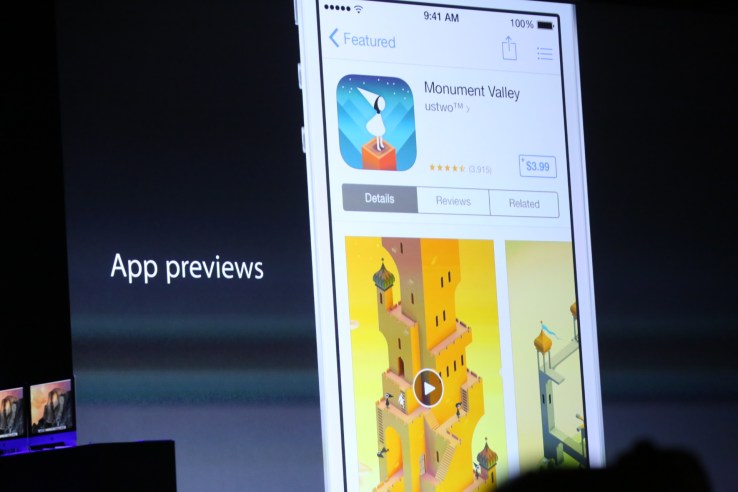
Apple announced a significant overhaul to the iTunes App Store on iOS this morning at WWDC in response to the challenges developers have faced as the store became increasingly crowded over the years. Today, there are 1.2 million iOS applications, meaning that the traditional means of finding “what’s hot” like the App Store’s Top Charts or Editor’s Picks, for example, are no longer enough. To address this problem, Apple is giving App Store search a serious makeover, with new features like “trending applications,” continuous scrolling, App Bundles, video previews and more.
“I do read your emails,” said Apple CEO Tim Cook with a chuckle, when detailing the App Store update.
In the iOS 8 App Store, which comes as a part of the forthcoming new version of Apple’s mobile operating system, users will have a new “Explore” tab that lets them delve deeper into the App Store’s offerings, including by category and subcategory.
Also new is a continuous scroll, which is more of a performance improvement related to moving through the App Store search results, which was not always the fastest way to navigate through a set of applications.
App Bundles, Video Previews, And More
Developers will also be able to create “App Bundles,” which help them better market and sell groupings of their applications to App Store shoppers. This would be helpful to those developers who specialize in certain types of applications, like a suite of apps for photo editing, for example.
Consumers will now have the option to buy these apps in bundles, which could potentially increase developers’ App Store sales.
A prominent children’s app developer, Toca Boca, was shown as an example of the App Store bundle with a grouping of apps called “Toca Toy Box,” which allows users to download a whole set of apps from the developer at a discount, when compared with buying the applications one-by-one.
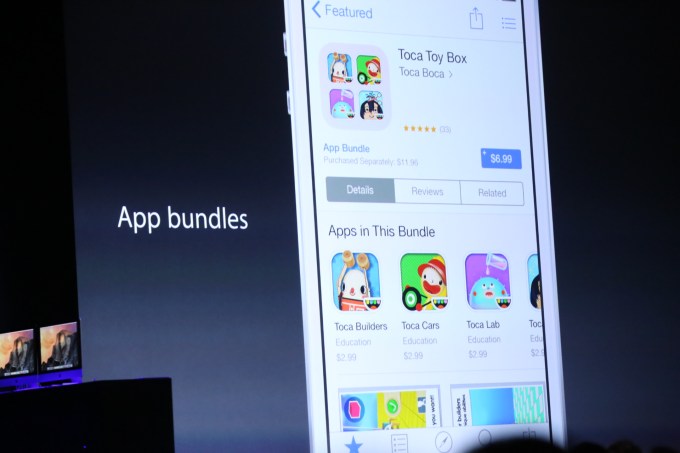
Meanwhile, a feature for video previews of apps – something that, we should point out, arrived on Android first – allows consumers to view the app in action before they make the decision to purchase. These short App Store videos are perfect for tweeting or sharing on Vine, and help to give a better idea about how an app looks and feels versus a screenshot, which can be misleading.
When played, the videos fill the screen, giving users an experience that’s as close as possible to what it’s like to use the actual application, without having to download it.
For developers who take the time to craft high-quality apps with elegant transitions and animations, videos will also help them better showcase those efforts. And for gamers, video previews will let them get a taste the gameplay before committing to a download.
Another feature involving related search suggestions that prompt you with other possible searches to try, also got a brief mention during the keynote, but this had already launched earlier this year.
And top apps that Apple likes will now get an Editor’s Choice logo to help with app recommendations.
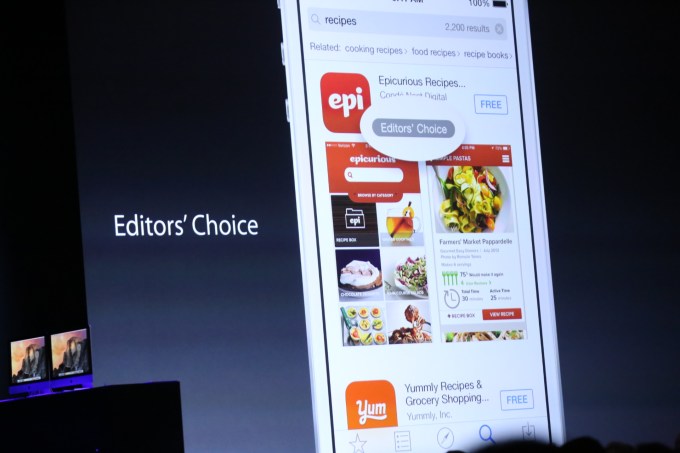
Family Sharing
A handy feature for multi-iOS device families is the new “family sharing” option, which will allow users to buy apps one time then share with others. This feature extends to other media as well, including photos, videos, calendars and reminders. Users will need to have the same payment card details on file for this to work, however, so no – you can’t “family share” with a just a bunch of friends.
The Family Share feature also lets parents approve children’s app purchases, which is a great addition that saves the grown-ups from constantly having to type in their App Store password. The feature will alert the parent via an approval notification, which is handy.
Trending Searches
The “Trending Searches” section in the App Store is very interesting, and possibly one of the more important features of the new release, as it gives developers another way to get their apps found.
You can think of this section as something like Twitter’s trends, as it will give a look at what’s currently hot on the App Store, without the reliance on App Store chart rankings, which have been repeatedly gamed by unsavory developers who know how to hack the algorithm. Apple didn’t clarify how ‘trending searches’ works, or how real-time it is, but it does appear that this, along with the other “Explore” features will replace the “Apps Near Me” section which debuted in iOS 7, and nearly really gained mainstream adoption as a way to find new apps, due to its limited use cases.
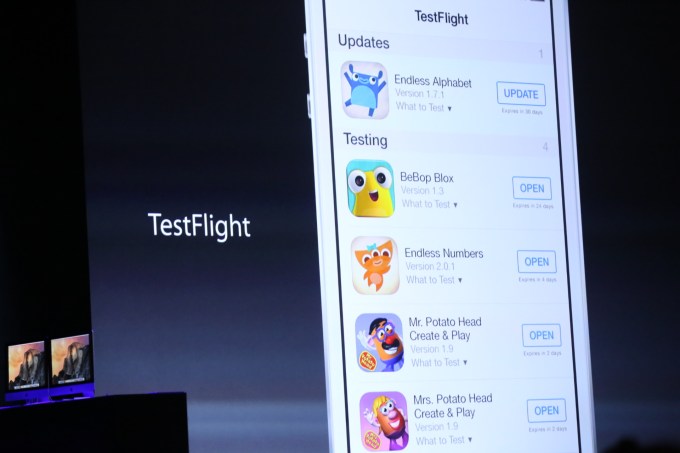
TestFlight
Not entirely unexpected was the announcement that recent Apple acquisition TestFlight, an app beta testing service, would now be integrated into the the developer center, giving developers native (and public!) app beta testing. You can read more about that changehere.
Related to the App Store changes, developers are also getting a new software development kit, with 4,000 new APIs to hook into. As a part of this change, developers can now build their own widgets for the Notification Center, but not the homescreen.
Posted by Sarah Perez (@sarahintampa)
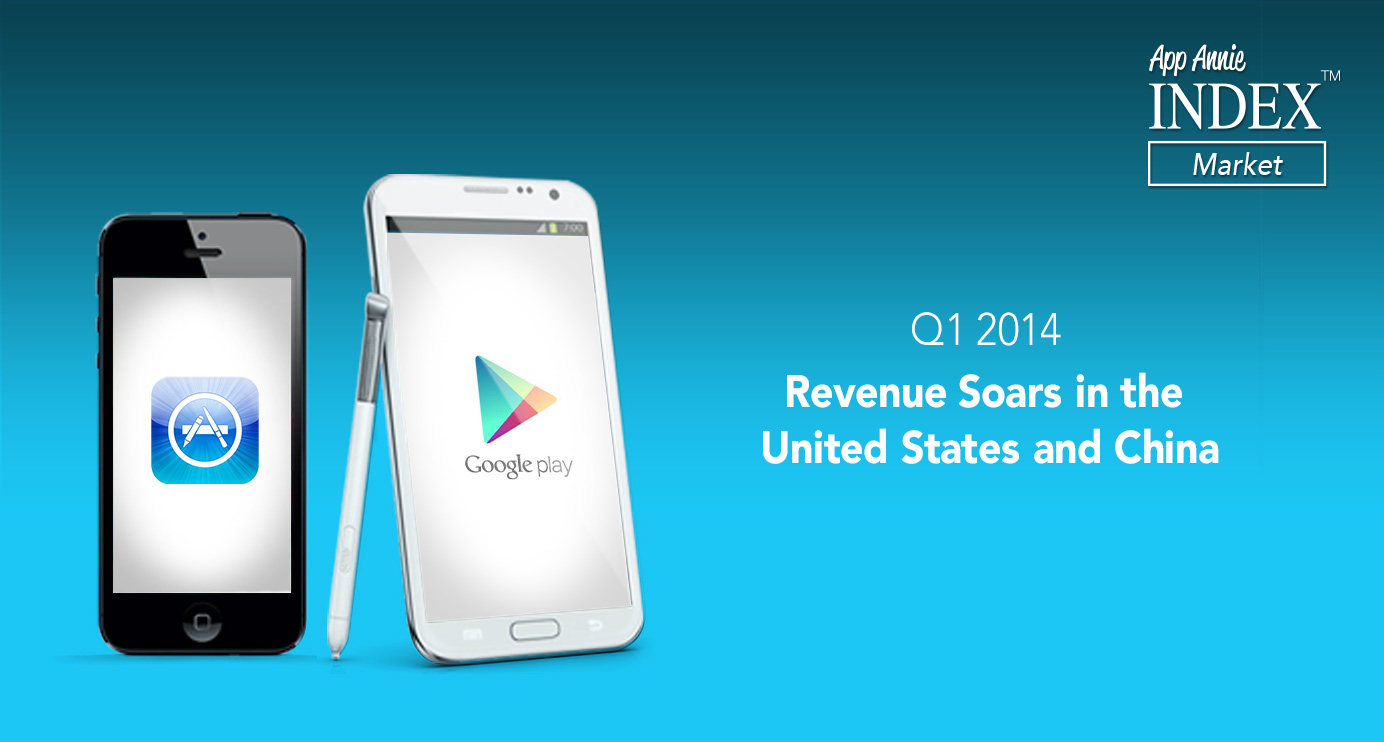 @Apppromo follows the App Annie Market Index and found the results for Q1 2014 very significant in terms of revenue in both the US and China markets. Please review and enjoy the following excerpts from the latest Market Index.
@Apppromo follows the App Annie Market Index and found the results for Q1 2014 very significant in terms of revenue in both the US and China markets. Please review and enjoy the following excerpts from the latest Market Index.
The information contained in this report was compiled using App Annie Intelligence, the industry-leading market data solution for identifying opportunities in the app store economy. It provides the most accurate market estimates for global app downloads and revenues – to learn more, take the tour or request a demo today.

iOS App Store vs. Google Play App Downloads & Revenue
Google Play led the iOS App Store in downloads by approximately 45% in Q1 2014, up from 35% in the previous quarter. Meanwhile, the iOS App Store maintained its comfortable advantage in revenue, leading Google Play by 85%. However, Google Play continued to narrow this revenue gap. The gains for Google Play come as Android devices extended their lead in worldwide device installed base.
Growth in Google Play downloads was driven by explosive growth in emerging markets, with Mexico and Turkey showing themselves as markets to watch. According to IDC, smartphone adoption has grown rapidly in Mexico, increasing around 75% in 2013 and expected to grow by approximately 40% in 2014. Over 65% of these devices used the Android OS, and this proportion is expected to increase in 2014. In Turkey, significant investment in IT and prominent technology projects as part of Vision 2023 and the FATIH education project are contributing to rapid device growth. According to IDC, IT spending is expected to increase around 9% in Turkey this year, driven primarily by the adoption of smartphones and tablets.
iOS App Store revenue growth was driven largely by China and the United States. However, impressive growth extended to smaller markets such as Vietnam and South Africa. Games remained the key category for revenue growth, but Finance apps also gained markedly, with worldwide category revenue growing around 45% quarter-over-quarter. This was boosted by the performance of TurboTax 2013 during tax season in the United States.
Games also topped growth in Google Play revenue, but other categories also saw notable revenue growth. In particular, Communication saw huge gains, and News & Magazines made a significant contribution. While emerging markets drove Google Play download growth, it was established markets such as the United States and United Kingdom that contributed the most to narrowing the revenue gap with the iOS App Store.